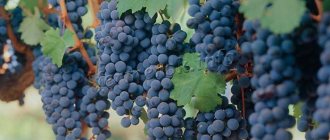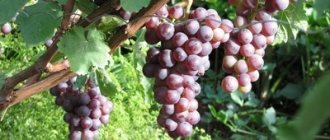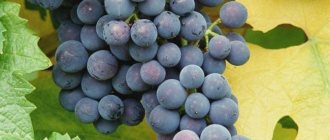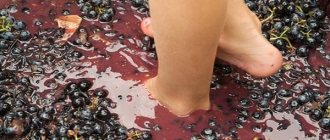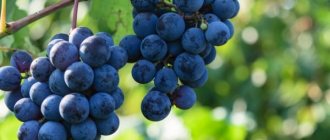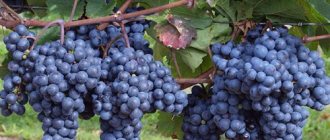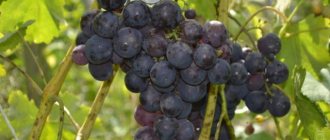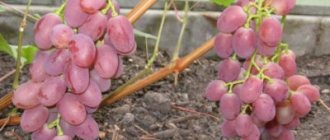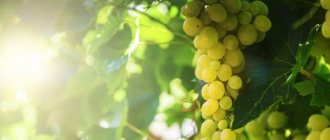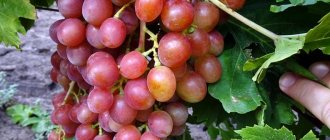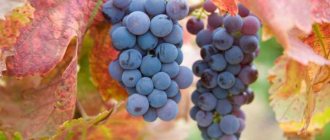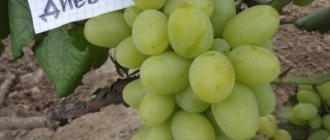Beautiful and productive beds with your own hands
Home › Bushes and trees › Description of the Russian Corinka grape: characteristics, photos, reviews from gardeners
Grapes are a revered healthy garden berry, the ripening of which we always look forward to. From the many varieties it is very difficult to choose the one that we like.
The Russian Korinka grape is a wonderful early-ripening variety that attracts with its undeniable advantages - high winter hardiness, abundant harvests, high quality fruits, unpretentiousness in cultivation and care.
Another noteworthy thing about it is that the berries do not contain seeds at all, and the vine is very decorative and will perfectly decorate any summer cottage.
Photo of Russian Korinka grapes.
Description of the variety and its characteristics
Russian Corinka is an amazing grape variety bred in the Tambov region by scientist-breeders L. Shtin and I. Filippenko, who crossed Zarya Severa with Kishmish black. The goal of the scientists was to achieve high winter hardiness of plants. The result was a frost-resistant species that could withstand temperatures down to -28 degrees.
Description of the vine
The variety's bushes, powerful and vigorous, will be a wonderful decoration for any garden building:
- plants are characterized by a high growth rate. They can reach 3 meters in length;
- the vine has strong shoots of light brown color, fully ripening, capable of holding a large harvest;
- the plant root system is well developed;
- leaves of Russian Corinka - five-lobed, large, slightly dissected, rich green in color;
- small white flowers form panicle inflorescences;
- the vine has flowers of both female and male flowering types, that is, the variety is self-pollinating and does not need pollinating varieties;
- Flowering of plants occurs in May. Flowering period - about 10 days;
- Fruiting of grapes occurs 2-3 years after planting.
Description of fruits and bunches
Russian Corinka is also called Radiant Kishmish for the sunny color of the fruits, which are simply beautiful in appearance and taste:
- the berries do not grow large. The mass of one barely reaches 2 g;
- fruit shape is regular round;
- the color is very attractive, golden with a soft pink blush;
- juicy aromatic pulp is covered with a thin but durable shell;
- There are no seeds inside the fruit, which is very attractive to children;
- the taste of the berries is rich grape, very sweet, without any extraneous flavors;
- The fruits of the variety are characterized by a high sugar content (up to 23%) with a low acid content (5 g per liter of grape juice).
Tasting rating on a five-point scale: 4.3 points.
The clusters of Russian Corinka are medium in size. The weight of one bunch varies from 180 to 250 g. The brushes are not very dense and have a conical shape. One brush grows on each shoot.
Usage
Russian Corinka is a table variety that absolutely everyone, especially children, love to enjoy fresh. The fruits make excellent jam and juice, compotes and jams. This type of grape is frozen, used to make raisins, added to gourmet desserts and fruit salads, and used as a filling for pies.
Winemakers can boast of delicious table wines made from this grape variety.
Ripening and harvesting dates
Kishmish radiata is an early ripening grape. Its growing season is only 110 days from the moment the leaves bloom. The berries ripen already in July. Full ripeness of the fruit occurs by mid-August. It is then that they begin to harvest.
Brushes can remain on the bushes for a long time without losing their taste and presentation. In this case, the fruits will accumulate the greatest amount of sugar.
Productivity
The variety is characterized by stable and high yields. Plants begin to bear fruit already in the second year of growth. With good care, you can collect up to 12 kg of sweet berries from one bush. Up to 80 centners of fruits are harvested from one hectare.
Shelf life and transportability
Russian Corinka berries remain on the bushes for a long time without losing their qualities. They can also be stored for some time in the refrigerator. The fruits tolerate transportation well over long distances, which is why the variety attracts the attention of farmers who cultivate it on an industrial scale.
Features of this variety
The main advantage of this grape is that it is a winter-hardy variety. Even at a frost of minus 28 degrees, it does not know any changes and continues to grow throughout your area. If the region does not have very cold winters, then you can leave it under piles of snow. This will not harm the grapes in any way, and they will feel good. This process can take a long time.
The appearance of the variety is ordinary, this can be seen from the description and the variety does not stand out in anything remarkable
When reading the descriptions for it, gardeners pay attention to the lines that characterize the leaves. They appear wrinkled in appearance and large
If you grow it in your own garden, you can achieve positive results.
Lush grape seedlings will attract attention and will appeal to all your guests. The leaves allow the formation of large seedlings and clusters.
This is typical for raisin-type grapes and you can’t count on a bunch of more than 200 grams. By planting these grapes in large quantities, you will have a harvest, and looking at the mass of individual bunches will not be relevant.
Appearance of fruits
Korinka Russian is able to offer you some pretty beautiful berries and this variety is perfect for sale. Externally, each berry has a golden hue with shiny barrels. The size of the grapes is not too large, but if you look at whole bunches, it is simply impossible to take your eyes off such beauty. The berries differ in characteristics and description:
- Juiciness.
- Meatiness.
- Moderate sweetness.
The sugar content of juice in this variety is no more than 22%. As for grapes, the taste can be recognized, it is very pleasant. Having tried it once, you can lie down with Korinka Russian for a long time. Most of all, your children will like these grapes. It is also worth noting that there is practically no smell from the bunches. The grapes do not produce aroma, it is difficult to sense it, and it dissipates in time. The skin of the berry is easy to remove, as it is distinguished by its thinness.
Taking into account that the berries in Korinka Russkaya are sweet, they are regularly attacked by hornets and wasps
It is important for the gardener to take into account and protect his crop by any possible means, or to harvest the crop before ripeness, it is important to take into account the description of the variety. You can collect bunches at any time, as they can easily hang on the bush until late autumn
Sweet Russian Korinka berries
Additional ways to use the variety
Thanks to such amazing properties and a description like that of Korinka Russkaya, it is often used to create raisins. The result is positive, satisfactory, and a number of consumers have not yet encountered such sweet raisins. There are no seeds in the berries of this variety, so when dried they are of very high quality. Consumers love to eat Russian Corinka, fresh, and this is right, because just at the height of the harvest, this fruit will be the healthiest for you.
Existing diseases affect grapes to a moderate degree, and it is important to take the description into account. Various types of fungi cause damage to the plant. To get rid of this scourge, it is recommended to carry out treatments several times throughout the entire ripening period. This will help keep the grapes in good condition for a long time and contribute to the appearance of a high-quality harvest.
Diseases and pests
This type of crop has average resistance to a number of diseases and pests, so there is a risk of contracting the main grape diseases:
- oidium, the symptom of which is a white coating on all parts of the plant. To avoid this problem, as a preventative measure in early spring, the vine is treated with a 3% solution of Bordeaux mixture (per 10 liters of water - 300 g of copper sulfate and 450 g of lime) or with the preparations Quadris, Tiovit and Topaz. Treatment is carried out before flowers bloom and after flowering;
- mildew, which manifests itself by the appearance of oily spots on the leaves. The disease is very dangerous and can destroy the entire vine, so it is best to prevent it. To do this, in the spring the grape bushes are sprayed with Bordeaux mixture or fungicides Antrakol, Strobi and Thanos;
- gray rot. The disease is characterized by the appearance of a gray coating. A solution of copper sulfate (per 10 liters of water - 10 g of the drug) will prevent the disease.
Oidium on grapes.
Birds and wasps love to feast on the fruits of Russian Corinka. To protect the crop, special bags are placed on the bunches to prevent pests from getting to the berries.
Features of growing the variety
First of all, it is worth noting that Russian currant is an early and productive grape; it ripens at the end of August. So if you want to pamper your loved ones with homemade fruits early, this variety is ideal. In addition, it is quite frost-resistant and can withstand temperatures up to 26 degrees below zero, which makes it possible to cultivate these grapes even in the Urals, the main thing is to remember to cover them in early November before the first frost.
It is propagated by cuttings, which take root quite easily in loose, nutritious soil and begin to bear fruit already 2 years after planting. The only problem in growing may be heavy rains, because the variety does not like excess moisture.
Corinka grapes do not have any special requirements for care and nutrition. It needs to be planted on the sunny side, where there is no strong wind. If these simple conditions are met, then the bush can bear fruit for up to 50 years.
Advantages and disadvantages
The variety has many advantages:
- good taste of berries;
- the ability to transport them over long distances;
- generous harvests;
- complete ripening of shoots;
- excellent winter hardiness and drought resistance;
- absence of seeds in fruits;
- highly decorative plants;
- unpretentiousness in cultivation and care;
- self-fertility;
- early maturation;
- versatility of fruit use.
The disadvantages include:
- weak immunity to disease;
- susceptibility to crop attack by wasps and birds.
How to use grapes
So, now you know what currant is, all that remains is to figure out how to use this grape variety. There are actually many options:
- Fresh berries are very healthy and contain many vitamins, acids and microelements.
- (kishmish) is stored for a long time, retaining all its beneficial properties. It can be used for baking, soaked and eaten, or made into a vitamin mixture from various dried fruits.
- This grape variety is also great for compotes, which will certainly delight children at the holiday table.
- Corinka is well suited for wine, although it is worth noting that the drink will turn out to be quite sweet; it is better to drink it diluted.
Landing
The conditions for planting this type of grape are simple. Even a beginner in viticulture can grow it:
- the variety is light-loving and does not like drafts, so choose a bright, dry and spacious place, protected from the wind;
- the soil must be breathable and fertile;
- the site is prepared ahead of time - the soil is dug up, weeds and roots are removed, organic and mineral fertilizers are added;
- a month before planting the seedlings, holes measuring 90 x 100 are prepared. The distance between the holes is left at least 3 m;
- the holes are filled up to half with a fertile mixture (chernozem + organic fertilizers);
- Seedlings are placed on this mixture, having straightened the roots well, and covered with earth;
- the ground is compacted, watered and sprinkled with mulch - humus, rotted mullein or peat.
general description
Russian Corinka was bred by breeders from the Tambov region Filippenko I.M. and Shtin L.T., who skillfully crossed Kishmish Cherny and Zarya Severa. A distinctive feature of Korinka is its ultra-early harvest. Ripe clusters begin to be picked already in July, while the berries of most varieties are just beginning to fill with juice. The growing season lasts on average 115 days. From her parents, Korinka inherited good immunity to diseases and good frost resistance. And although in the central regions of the country it is preferable to keep grapes under cover in winter, summer residents note that the plant can tolerate frosts down to -25 degrees without harm to the crop.
The plant bears fruit in the third year after planting. The peak productivity of the variety is attributed to the age of 5-8 years. Then the yield drops slightly. You can improve performance with the help of anti-aging pruning, when the shoots are severely pruned.
has good survival rate. Cuttings can quickly take root in almost any soil and on any rootstock.
Fact! Corinka itself can act as a rootstock for less demanding and cold-resistant varieties.
Care
Caring for Russian Corinka is practically no different from caring for other varieties of crops:
- plants need regular and abundant watering, but stagnation of moisture should not be allowed. Water the vine as the soil dries out. During hot and dry summers, the amount of watering is increased;
- Fertilizing begins in the second year of vine growth. Russian Corinka does not react well to an excess of fertilizer, so fertilizer is applied only once during the entire season. Both organic substances and mineral fertilizers are used for fertilizing;
- for better growth and fruiting, branches and shoots of grapes are tied to a trellis;
- the vine needs formative, thinning, and sanitary pruning, carried out both in autumn and spring;
- to avoid disease, the soil around the vine is kept clean, free from weeds and organic debris;
- loosening is necessary to ensure access of oxygen to the root system;
- Before the onset of cold weather in regions with harsh winters, grape bushes are insulated - the vine is carefully removed from the trellis, laid on the ground, covered with either agrofibre or spruce branches, and sprinkled with earth on top.
Corinka - what is it?
Many people come across this name in baking recipes, but do not know what kind of “beast” it is.
Korinka is a name for small black seedless raisins. Its main purpose is as a seasoning or ingredient in baking. Corinka, like all dried fruits, has many beneficial properties, and its calorie content is 224 kcal per 100 grams. Very often, shadberry is confused with currant, although they have nothing in common. Corinka raisins are obtained from a special seedless raisin. Although it still contains seeds, they are very soft and practically unnoticeable, which is what cinnamon is famous for. We found out what it is, now we’ll find out how these raisins are obtained.
Reviews from gardeners about the Korinka Russian grape variety
Gardeners and winegrowers speak positively about this type of crop. They really liked the sweet golden fruits of the Russian Corinka.
Alexey, 50 years old
“In the Leningrad region, Korinka ripens at the end of August and beginning of September, but I am never in a hurry to harvest. If the bunches hang on the bushes for a while, the taste of the berries will improve much. They will accumulate sugars and become much sweeter. I like this variety: although its fruits are small, they are so distant! I will never give it up."
Inga, 44 years old
“I’m new to viticulture. Knowledgeable people advised to start with Russian Korinka. This is a wonderful unpretentious variety, resistant to adverse weather conditions, which produces harvests in any weather. And the taste of berries is even very attractive. My kids really like it."
Reviews
Alexei
It seems they say Korinka is an unpretentious variety. However, in the conditions of the Leningrad region, you need to try hard to grow decent grapes of this variety. Apparently it is not adapted to frequent rainfall. In conditions of high humidity, he constantly gets sick. In one place it rots, in another it becomes covered with brown spots, in a third the fruits fall off. Whatever I sprayed him with, not a single poison helps. As a result, they manage to produce the harvest, but nothing comes of it at all. In general, the variety, at least for me, is not suitable.
Nina
I have been growing Korinka for many years. At first there were problems with the grapes, either wasps ate the fruits or powdery mildew attacked. But then I adapted to the biology of the plant and all the problems resolved themselves. I lead him in two long sleeves that stretch along my fence. It is very difficult to tell at four, since the shoots grow very quickly and become woody, and cutting them is troublesome. And so one lash goes in one direction, the other in the other. The grapes grow in the sun; waterlogging is excluded, since we have little precipitation in the summer. It is important to apply mineral fertilizers. And not just potassium and phosphorus, but complex mineral fertilizers, which grapes love very much.
Characteristics
- The variety is winter-hardy. Bushes can withstand temperatures down to -25 -28 degrees. In the southern regions, grapes are not covered for the winter. In our region, the plant is recommended to be grown as a cover crop. You need to prepare grapes for the winter before the first cold weather begins (before October 10-15).
Tukai, Super Extra and Arched are also distinguished by such winter hardiness.
The variety is characterized by an average (or above average) yield (80-85 c/ha). The vine ripens well (2/3-6/7 total length).
The cuttings quickly take root and begin to grow actively. Already in the first years you can get a bountiful harvest from the bush. Fruiting coefficient 0.8.
It is recommended to grow Russian currant on a trellis in a four-armed culture. This method is optimal for obtaining a good harvest, as is the case with the varieties Delight and Manicure Finger. The variety is most often grown for fresh consumption and for making raisins. It is suitable for home canning and sweet dishes.
Recommendations for agricultural technology
The Korinka Russian grape is unpretentious in care, so it is ideal for beginning winegrowers. The main requirements for stable yield and growth are good lighting and absence of drafts.
Seedlings are planted at the beginning or end of the growing season. A month in advance, you need to dig a hole and fertilize it with various pharmaceuticals, but black soil is best suited for this.
What is a smoothie and what are the benefits of it - a description of smoothie delivery in St. Petersburg
How grapes are dried
There are many ways to dry grapes, but not all of them can be used at home.
To turn juicy berries into raisins, it is best to use solar-air drying. The bunches are sorted and placed on wooden or plastic trays covered with paper and left in a ventilated area in the sun. Basically, a veranda or balcony is used for these purposes. During drying, you need to periodically turn the bunches for better drying. This way you will prevent fermentation and rotting. The bunches need to be turned over at least once every three days. With good weather and the right technique, in a month you will have ready-to-eat raisins. It should be stored in a cool, dark place, wrapped in paper. Another method involves using drying. With its help you can significantly speed up the process
This is important if you decide to prepare a lot of raisins, but the weather does not allow this. This method involves uniform supply and distribution of warm air in drying
The speed of the procedure depends on the power of the equipment and its technical characteristics. On average, at the first stage of drying, a temperature of 60-70 degrees is sufficient, and at the last - 40-50 degrees. Thus, one batch of raisins will be ready in 1-2 days.
There is a misconception about the Russian Korinka grape variety - that it is a whimsical plant, difficult to grow. Having applied the acquired knowledge in practice, you will be convinced of the absurdity of this statement.
What type does it belong to?
Russian Corinka is a seedless table grape variety . Among the famous varieties of boneless grapes one can also name Kishmish Radiant. A distinctive feature is the very early ripening of the berries . The harvest begins in late July or early August. Full maturity occurs after 110-115 days from the growing season. Only Gordey, Harold and Super-early Amethyst can still boast of the same timing.
